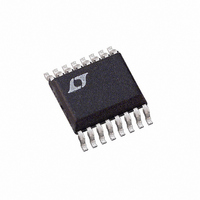LTC3703EGN Linear Technology, LTC3703EGN Datasheet - Page 12

LTC3703EGN
Manufacturer Part Number
LTC3703EGN
Description
IC BUCK/BOOST SYNC ADJ 5A 16SSOP
Manufacturer
Linear Technology
Type
Step-Down (Buck), Step-Up (Boost)r
Datasheet
1.LTC3703EGNPBF.pdf
(32 pages)
Specifications of LTC3703EGN
Internal Switch(s)
No
Synchronous Rectifier
Yes
Number Of Outputs
1
Voltage - Output
0.8 ~ 93 V
Current - Output
5A
Frequency - Switching
100kHz ~ 600kHz
Voltage - Input
9.3 ~ 100 V
Operating Temperature
-40°C ~ 85°C
Mounting Type
Surface Mount
Package / Case
16-SSOP
Lead Free Status / RoHS Status
Contains lead / RoHS non-compliant
Power - Output
-
Available stocks
Company
Part Number
Manufacturer
Quantity
Price
Company:
Part Number:
LTC3703EGN
Manufacturer:
LINEAR
Quantity:
4
Part Number:
LTC3703EGN
Manufacturer:
LTNEAR
Quantity:
20 000
Company:
Part Number:
LTC3703EGN#PBF
Manufacturer:
LT
Quantity:
3 291
Part Number:
LTC3703EGN#PBF
Manufacturer:
LINEAR/凌特
Quantity:
20 000
Company:
Part Number:
LTC3703EGN#TRPBF
Manufacturer:
LT
Quantity:
3 291
Part Number:
LTC3703EGN#TRPBF
Manufacturer:
LTNEAR
Quantity:
20 000
Company:
Part Number:
LTC3703EGN-5
Manufacturer:
LT
Quantity:
10 000
Part Number:
LTC3703EGN-5
Manufacturer:
LINEAR/凌特
Quantity:
20 000
Company:
Part Number:
LTC3703EGN-5#PBF
Manufacturer:
LT
Quantity:
320
Part Number:
LTC3703EGN-5#PBF
Manufacturer:
LINEAR/凌特
Quantity:
20 000
LTC3703
OPERATION
Buck or Boost Mode Operation
The LTC3703 has the capability of operating both as a
step-down (buck) and step-up (boost) controller. In boost
mode, output voltages as high as 80V can be tightly regu-
lated. With the INV pin grounded, the LTC3703 operates
in buck mode with TG driving the main (topside) switch
and BG driving the synchronous (bottom side) switch.
If the INV pin is pulled above 2V, the LTC3703 operates
in boost mode with BG driving the main (bottom side)
switch and TG driving the synchronous (topside) switch.
Internal circuit operation is very similar regardless of the
APPLICATIONS INFORMATION
The basic LTC3703 application circuit is shown in Figure 1.
External component selection is determined by the input
voltage and load requirements as explained in the following
sections. After the operating frequency is selected, R
and L can be chosen. The operating frequency and the
inductor are chosen for a desired amount of ripple current
and also to optimize effi ciency and component size. Next,
the power MOSFETs and D1 are selected based on voltage,
load and effi ciency requirements. C
ability to handle the large RMS currents in the converter
and C
output voltage ripple and transient specifi cations. Finally,
the loop compensation components are chosen to meet
the desired transient specifi cations.
Operating Frequency
The choice of operating frequency and inductor value is
a trade-off between effi ciency and component size. Low
frequency operation improves effi ciency by reducing
MOSFET switching losses and gate charge losses. However,
lower frequency operation requires more inductance for a
given amount of ripple current, resulting in a larger induc-
tor size and higher cost. If the ripple current is allowed
to increase, larger output capacitors may be required to
maintain the same output ripple. For converters with high
step-down V
the minimum on-time of the LTC3703 (see the Minimum
On-Time Considerations section). A fi nal consideration for
12
OUT
is chosen with low enough ESR to meet the
IN
to V
OUT
(Refer to Functional Diagram)
ratios, another consideration is
IN
is selected for its
SET
operating mode with the following exceptions: in boost
mode, pulse-skip mode operation is always disabled
regardless of the level of the MODE/SYNC pin and the
line feedforward compensation is also disabled. The
overcurrent circuitry continues to monitor the load cur-
rent by looking at the drain voltage of the main (bottom
side) MOSFET. In boost mode, however, the peak MOSFET
current does not equal the load current but instead
I
count when programming the I
operating frequency is that in noise-sensitive communica-
tions systems, it is often desirable to keep the switching
noise out of a sensitive frequency band.
The LTC3703 uses a constant frequency architecture that
can be programmed over a 100kHz to 600kHz range with
a single resistor from the f
in Figure 1. The nominal voltage on the f
and the current that fl ows from this pin is used to charge
and discharge an internal oscillator capacitor. The value of
R
Figure 7 or from the following equation:
D
SET
= I
R
SET
LOAD
for a given operating frequency can be chosen from
(
k
1000
/(1 – D). This factor needs to be taken into ac-
Ω =
100
10
Figure 7. Timing Resistor (R
1
)
0
f kHz
(
7100
200
) –
FREQUENCY (kHz)
25
400
SET
600
pin to ground, as shown
MAX
800
voltage.
SET
) Value
3703 F07
SET
1000
pin is 1.2V,
3703fb













